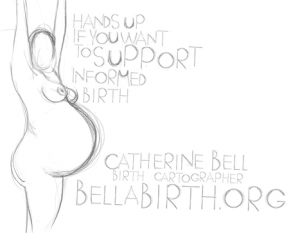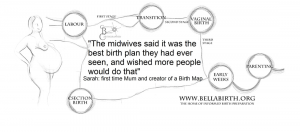“The Birth Map evolved to address the needs of modern birthing women. There is no one way. The Birth Map helps you find your way. No matter what… It assumes nothing and prepares for everything.”
A powerful preface within Catherine Bell’s first book and for any woman looking for confidence, knowledge and know-how in preparing for the birth of their child.
The Birth Map redefines what birth preparation looks like and steers women in a new direction away from the often dismissed and frequently debated birth plan. Whilst a birth plan outlines the desires and wishes of a birthing woman (and their partner), The Birth Map is a preparation process based on informed decisions that can be given to all members of the birth support and care team. It outlines the woman’s well informed choices for every imaginable possibility that can occur during birth.
Easy to read, navigate and follow, Bell’s book sets every reader up for a successful journey towards birth. This book can be dog-eared and used over and over again no matter the number of pregnancies its reader has had/or will have.

Divided into three sections, Bell takes the reader on a well thought out journey which allows them to identify the power they have to birth their way.
The Insights
Bell begins by outlining what maternity care looks like in Australia and provides her readers with a simple yet impactful description of what support and care is available to them and how they can maximise their options.
She beautifully details what informed decisions are, breaking them down into three parts: prior understanding, current circumstances, and new information; and describes to her readers how to know they are making informed decisions. This attention to detail offers the reader a greater understanding and sets them up to trusting and acknowledging the power they already possess.
Providing readers with a detailed evaluation of what risk is, Bell invites her readers to evaluate and discern how the words risk, chance and danger are used within the conversation around birth and how Bell’s take on the BRAIN (Benefit, Risk, Alternatives, Intuition, Nothing) tool can be used to evaluate any risk throughout the mapping process.
“ There was danger she could birth at home
There was a risk she could birth at home
There was a chance she could birth at home
There was an opportunity she could birth at home”
Prepared with the understanding of the difference between a plan and a Map, the reader is formally introduced to what a Birth Map can look like and how it is used. Empowering women to see themselves as the driver of their own journey, Bell anecdotally describes how every possible route and pathway can be prepared for and how as driver, the birthing woman sets the rules.
The Birth Map prompts the necessary discussions with care providers, reminding everyone to pay attention to what the woman has already given her informed consent or refusal to. Bell breaks down the language of the Birth Map, providing alternatives to the language used in birth plans and identifies that each point made on a Birth Map is an informed decision and therefore does not require any justification.

The Questions
Section 2 provides the reader with an in-depth array of questions to ask of not only the support/care team and partner but of oneself prior to birth. Bell outlines question by question how to ‘set the scene’ and build the foundations for the Birth Map.
She explores each possible detour throughout the 3 stages of birth a woman may face and what questions to ask to ensure she has the ability to make informed decisions. What is worth noting is that whilst Bell demonstrates the power of physiological birth she does not ever delude the reader into believing physiological is the right way/or only way. It is present when reading this book how much Bell believes that there is no right way to birth and that every journey is different, leaving the reader confident they are setting the tone, direction and rules for their own birth experience.

Beyond Birth
As the title suggests, the final section of The Birth Map takes the reader beyond the birth and into the first weeks post birth; and years beyond as a parent. Bell provides practical, impactful and easily understood insights into how to prepare for life after birth, covering an array of different topics. Her approach to gathering supporters in preparation for the first weeks of parenthood is simple yet impactful. She highlights what gifts of love look like and what questions to ask oneself when creating a circle of support.
Whilst the final section is somewhat brief it certainly does not fall short of providing the reader with valuable starting points and food for thought when looking at life as a parent beyond the 6 month mark. A highlight is her support around preparing siblings for the arrival of a new family member.
Throughout the book Bell refers to many powerful women in the birth work world and has a great reference guide at the end of the book to support every reader in researching beyond this book.
The Birth Map is a must have for everyone birthing woman, whether it is her first birth or one many. Empowering, guiding, supporting and informing, Catherine Bell really has taken planning for birth in a much needed direction.
Personally, as a Doula and coach, I see the value in all Doulas/birth workers working with their clients with the Birth Mapping model. Supporting every birth, no matter the outcome.
Book Review by Erin Brass.
If you would like to purchase the Birth Map hard copy book or eBook, go to the Birth Map website:
CATHERINE BELL BIRTH CARTOGRAPHER – Catherine Bell Birth Cartographer (bellabirth.org)
My name is Erin Brass and I am a qualified doula who has trained at the Doula Training Academy. If you would like more information about my doula services please contact me:
Email: [email protected]
Facebook: https://www.facebook.com/erin.brass
Instagram: https://www.instagram.com/erinbrass/

